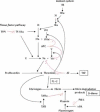Review: Viral infections and mechanisms of thrombosis and bleeding
- PMID: 22930518
- PMCID: PMC7166625
- DOI: 10.1002/jmv.23354
Review: Viral infections and mechanisms of thrombosis and bleeding
Abstract
Viral infections are associated with coagulation disorders. All aspects of the coagulation cascade, primary hemostasis, coagulation, and fibrinolysis, can be affected. As a consequence, thrombosis and disseminated intravascular coagulation, hemorrhage, or both, may occur. Investigation of coagulation disorders as a consequence of different viral infections have not been performed uniformly. Common pathways are therefore not fully elucidated. In many severe viral infections there is no treatment other than supportive measures. A better understanding of the pathophysiology behind the association of viral infections and coagulation disorders is crucial for developing therapeutic strategies. This is of special importance in case of severe complications, such as those seen in hemorrhagic viral infections, the incidence of which is increasing worldwide. To date, only a few promising targets have been discovered, meaning the implementation in a clinical context is still hampered. This review discusses non-hemorrhagic and hemorrhagic viruses for which sufficient data on the association with hemostasis and related clinical features is available. This will enable clinicians to interpret research data and place them into a perspective.
Copyright © 2012 Wiley Periodicals, Inc.
Figures

References
-
- Abgueguen P, Delbos V, Chennebault JM, Payan C, Pichard E. 2003. Vascular thrombosis and acute cytomegalovirus infection in immunocompetent patients: Report of 2 cases and literature review. Clin Infect Dis 36:E134–E139. - PubMed
-
- Adalja AA. 2010. Hematemesis in a 2009 H1N1 influenza patient. Am J Emerg Med 28:846–854. - PubMed
-
- Agarwal PP, Cinti S, Kazerooni EA. 2009. Chest radiographic and CT findings in novel swine‐origin influenza A (H1N1) virus (S‐OIV) infection. AJR Am J Roentgenol 193:1488–1493. - PubMed
-
- Akiyama R, Komori I, Hiramoto R, Isonishi A, Matsumoto M, Fujimura Y. 2011. H1N1 influenza (swine flu)‐associated thrombotic microangiopathy with a markedly high plasma ratio of von Willebrand factor to ADAMTS13. Intern Med 50:643–647. - PubMed
-
- Alexeyev OA, Morozov VG, Efremov AG, Settergren B. 1994. A case of haemorrhagic fever with renal syndrome complicated by spleen haemorrhage. Scand J Infect Dis 26:491–492. - PubMed
Publication types
MeSH terms
LinkOut - more resources
Full Text Sources
Other Literature Sources
Medical
Research Materials

